Two labs race to discover a cure—who will be the one to Save Patient Zero?
What Is Save Patient Zero?
Save Patient Zero is a deduction game for 2 to 7 players (in two teams, usually with a game master), ages 10 and up, and takes about 30 minutes to play. It’s currently seeking funding on Kickstarter, with a pledge level of €35 (about $43USD) for a copy of the standard game, or €55 (about $67USD) for a copy of the deluxe game. The game primarily uses a process-of-elimination deduction, and the rules were easy enough to learn for my 8-year-old, though she did need some help at times with the deduction part; playing on teams should make it possible to play with kids younger than 10 as well.
Save Patient Zero was designed by Cédroc Martinez and published by Helvetiq, with illustrations by Emiliano Ponzi and graphic design by Felix Kindelán.
New to Kickstarter? Check out our crowdfunding primer.

Save Patient Zero Components
Note: My review is based on a prototype copy, so it is subject to change and may not reflect final component quality. The player screens will likely have more artwork on them, as seen in the Kickstarter video.
Here’s what comes in the standard game, which matches the prototype I received:
- 2 Player screens
- 25 Molecule cards
- 2 Scanpad frames
- 2 Pencils
- 2 Centrofugo tokens
- 60 Worksheets
- 80 Sample cards (40 per lab)
- 36 Tool cards (18 per lab)
The deluxe edition will include 2 laminated worksheets and dry erase markers instead of the paper and pencil of the standard edition, and will also include a Foldscope, a paper microscope (which is not actually used in the game).
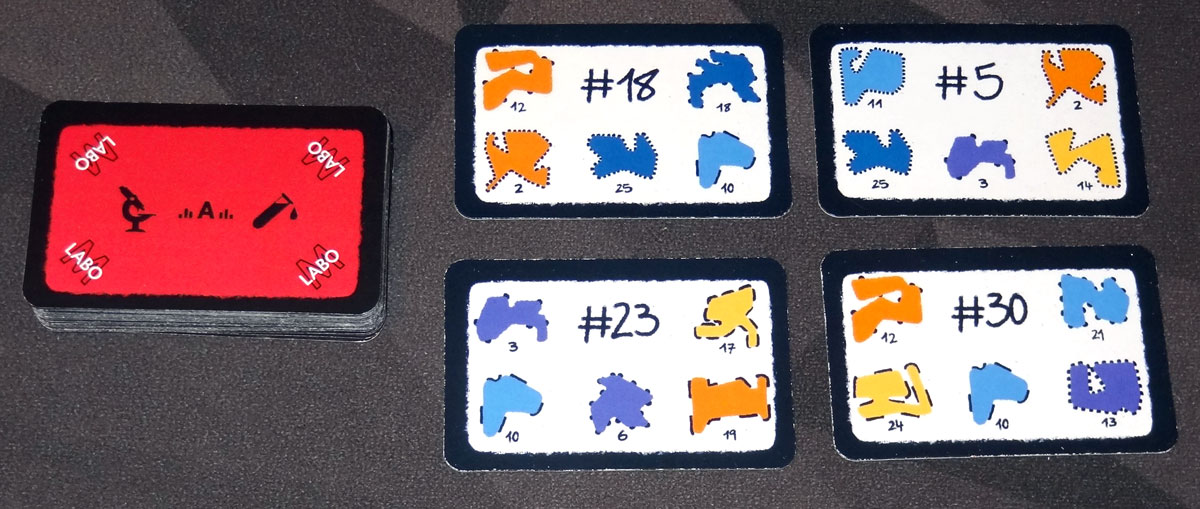
The game’s illustrations are primarily in blue and red, also used to represent the two different teams, with some additional colors used in some of the molecules. Emiliano Ponzi is a magazine illustrator and that gives the game a sort of graphic poster style: simple diagrams that have some rough edges to give it a more hand-drawn feel. The molecules themselves are abstract shapes in different colors, with dotted or dashed outlines (though the shape and colors are simply there for thematic purposes and aren’t strictly necessary for the gameplay).
The components themselves are fairly simple: some small, Euro-size cards, the worksheet itself, and some cardboard tokens including the window-like Scanpad. The player screens are a bifold cardstock, and the inside has a description of all the tools and how they’re used, so it serves as a player aid.
How to Play Save Patient Zero
You can download a copy of the rulebook here. It’s also available to play on Tabletopia, though only in two specific play modes: the 2 team “No Savvy Mode,” and the 1 team “Lean Mode.”
The Goal
The goal of the game is to be the first to identify the 3 molecules needed for the antidote.
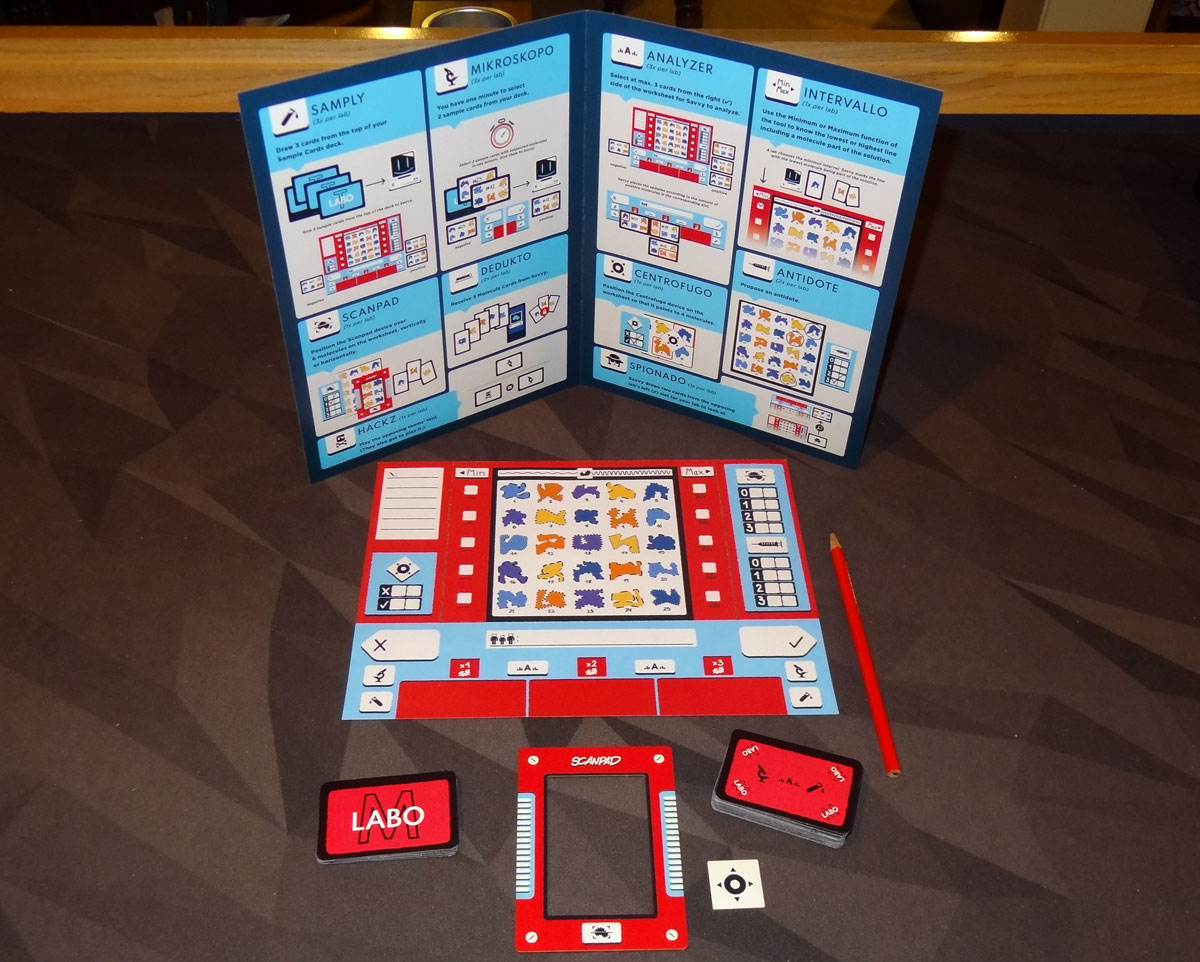
Setup
There will be two teams, as well as a game master who plays the role of Savvy, the computer. (There are other game modes as well, but this is the standard mode.)
Each player takes the following components: a worksheet and writing utensil, a Scanpad frame, a Centrofugo token, and the tool cards and sample cards of their color. Place the player screen so that the other team can’t see your worksheet. You might find it helpful to sort out your tool cards, though if you spread them out the other team may be able to see what tool you’re picking.
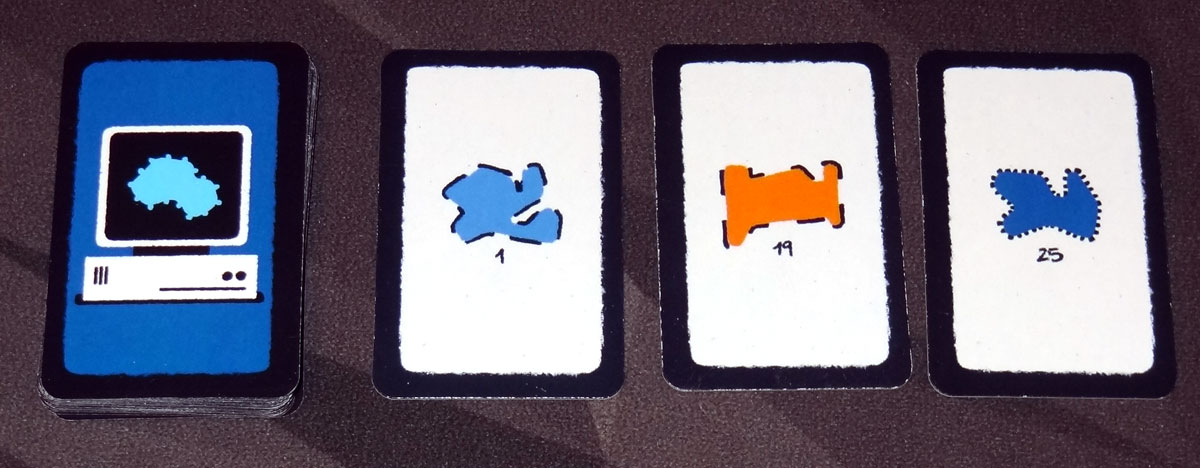
Savvy shuffles the molecule cards and secretly draws 3 cards. These 3 molecules are the solution that the two labs will be looking for.
Gameplay
Each round, both teams choose a tool card from their deck and play it face-down. Whoever chooses their tool first goes first that round. Savvy takes both cards and reveals them.

- Samply: The lab gives Savvy 3 cards drawn from their sample deck and Savvy sorts them.
- Mikroskopo: The lab has 1 minute to choose 2 cards from their sample deck for Savvy to sort.
- Antidote: Propose a solution of 3 molecules; Savvy indicates how many target molecules you got correct.
- Dedukto: Savvy draws 5 cards from the molecule deck and gives it to the lab, allowing them to eliminate those 5 molecules.
- Intervallo: The lab chooses Minimum or Maximum; Savvy marks which row on their sheet has the lowest or highest numbered molecule.
- Centrofugo: The lab places their Centrofugo token pointing to 4 molecules, and Savvy indicates if there are any target molecules in that group.
- Scanpad: The lab places the Scanpad surrounding 6 molecules; Savvy marks how many target molecules are visible.
- Analyzer: The lab chooses 3 sample cards from their play area and Savvy indicates how many target molecules are on each card.
- Spionado: Savvy draws 2 cards from the other lab’s “no” slot for you to look at, and then they are returned.
- Hackz: Copy whatever tool the other team chose for this round.
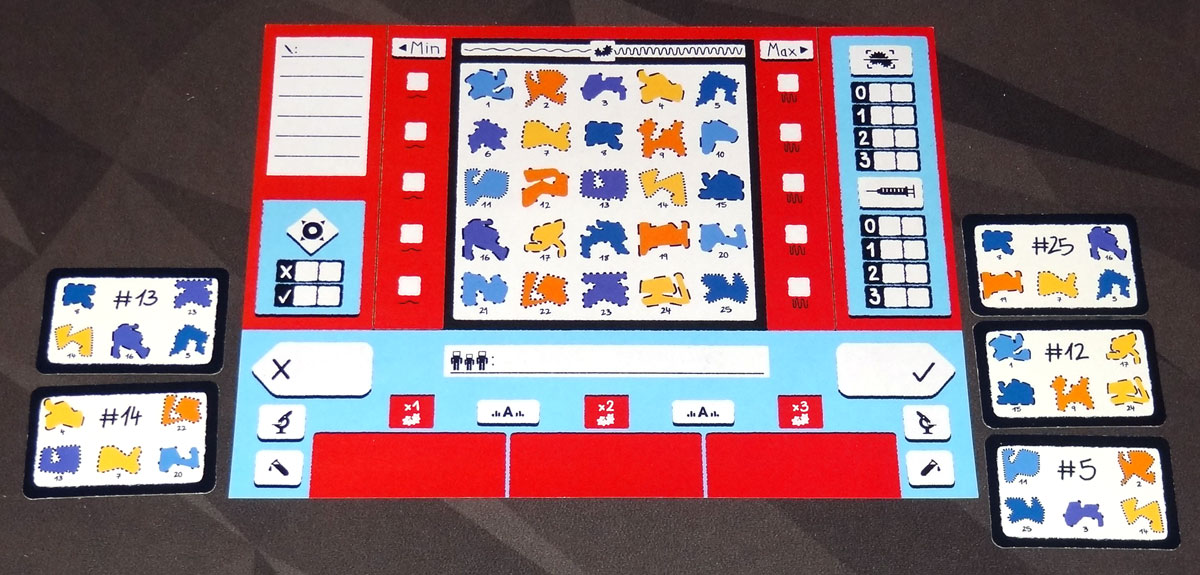
For both the Samply and Mikroscopo tools, the sample cards provided to Savvy are then placed on the left or right of their worksheets (next to the X and the checkmark) based on whether they include any target molecules in them.
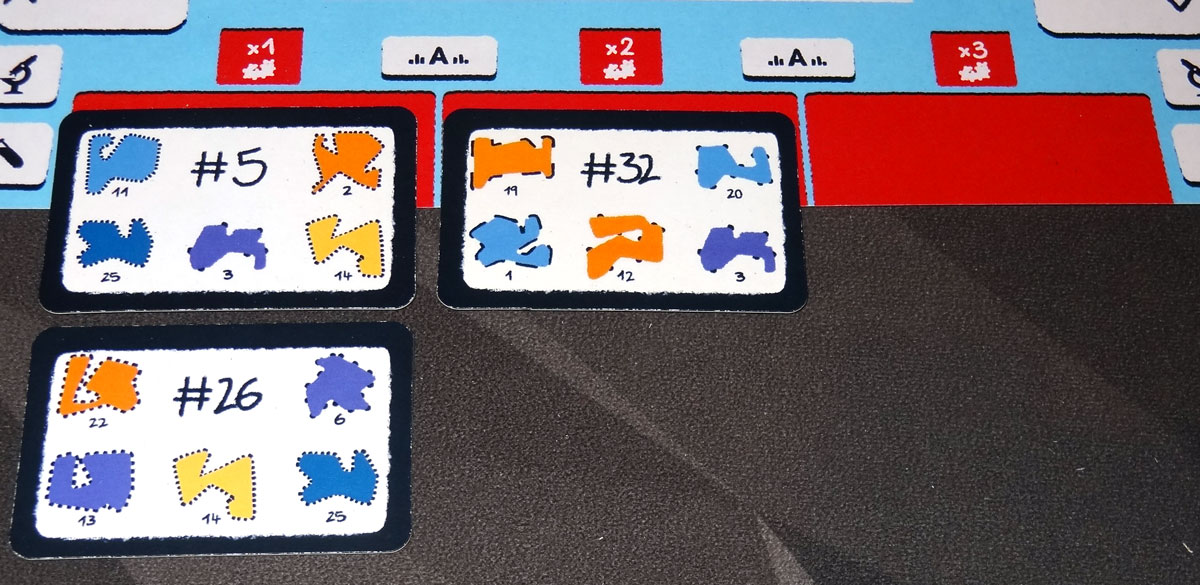
Using the Analyzer tool on up to 3 cards from the “yes” side of the worksheet then gives you more information: Savvy will place the cards into three columns, indicating how many target molecules are on each of the cards.
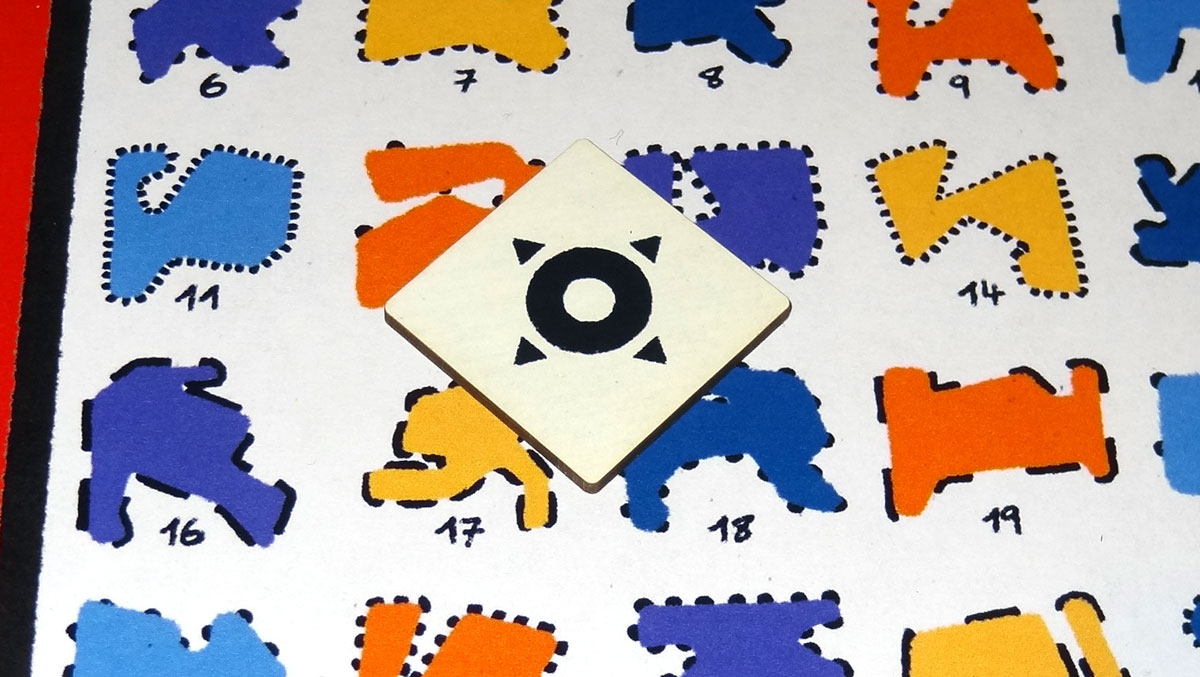
Centrofugo tests 4 molecules, but only gives you a “yes/no” answer about whether any of the target molecules were included. It doesn’t indicate how many of the molecules were targeted or which ones.
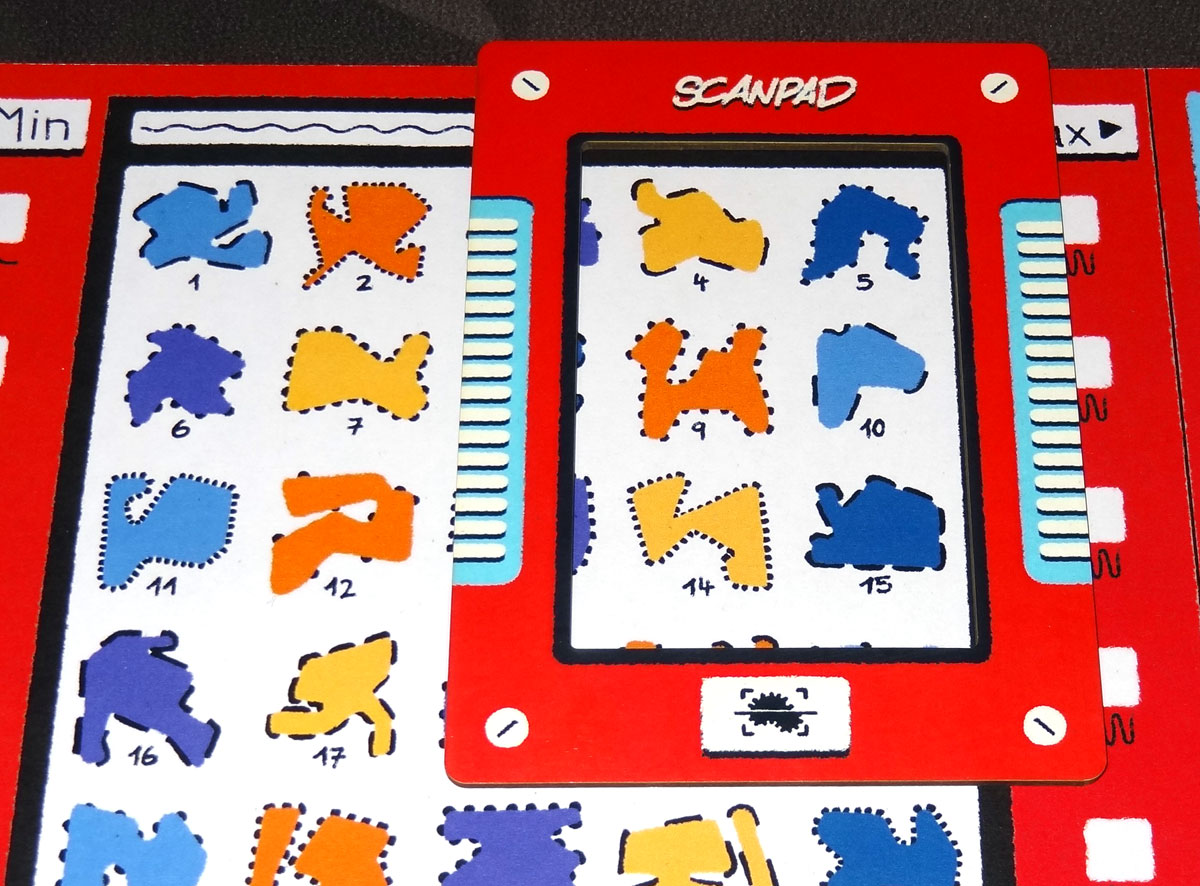
The Scanpad gives you a little more info: Savvy will mark how many target molecules (from 0 to 3) are shown in the Scanpad window.
Game End
The game ends when a lab successfully creates the antidote with all 3 target molecules. Since you only have 2 antidote cards, you only get two chances to win. If you use both of your antidote cards without finding the solution, then you lose. While the rules don’t explicitly say so, I think if both teams use up their antidote cards, then they both lose because patient zero never gets a cure.
Variant Game Modes
There are a few other variants included in the rules:
- No Savvy Mode: Instead of having a separate player as Savvy, each team draws 3 molecule cards and acts as Savvy for the opposing team. The Spionado card is removed from the game.
- Lean Mode: There’s only 1 lab, plus a player as Savvy. The lab tries to find the antidote while using the fewest tools (comparing the number used to a scoring chart).
- Friendly Mode: Remove the Spionado and Hackz tools.
- Agile Mode: Randomly remove 6 tool cards from each deck at setup (but not the 2 Antidote cards).
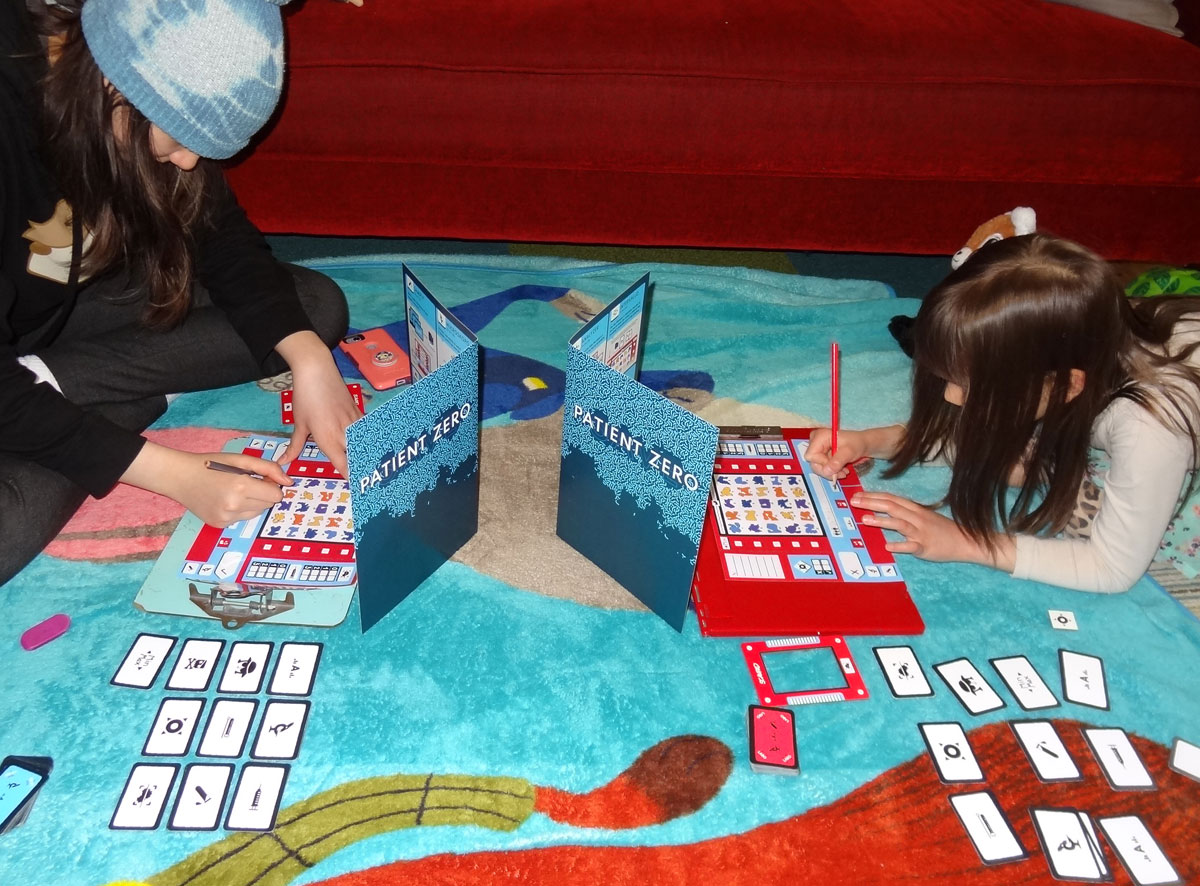
Why You Should Play Save Patient Zero
Save Patient Zero was actually in development well before the COVID-19 pandemic, and was inspired in part by competing pharma companies in Basel, Switzerland, where the publisher is based. (It also drew some inspiration from the rivalry between Pasteur and Koch in the 1880s.) Now, of course, it’s hard to separate the theme from current events: as you’re trying to pin down the molecules needed to cure the disease, it brings to mind scientists working quickly to develop the vaccine over the past year.
Helvetiq is an experienced publisher: they have over 70 games (including Bandido and Hippo, which I’ve reviewed). Not all of their games are the tiny box games, but Save Patient Zero is their first “big box” game and the first one they’re trying to fund through Kickstarter. They’re also working on an app so that players can go head-to-head with an app serving as Savvy.
I’ve tried out Save Patient Zero on Tabletopia in the “No Savvy Mode,” and I also served as Savvy while my kids played against each other. (Since I’m still not hosting games, my options for trying out the game were somewhat limited.) I think the standard mode is more fun, with both teams racing to identify the same set of molecules, but it does require an extra person to act as Savvy (at least, until the app is completed). In the “No Savvy Mode,” since you’ve drawn 3 cards as the solution for the other lab, you can already eliminate those 3 molecules on your own sheet, so both teams get a bit of a head start. I haven’t gotten to play with larger groups, though if you’re playing with teams you’ll have to figure out how to communicate with each other without giving away too much to the other lab.

The deduction is primarily based on elimination: any card put on the “no” side from the Samply or Mikroskopo tool lets you cross out all five molecules shown on that card. Likewise, getting a “no” result from Centrofugo seems more useful because you can eliminate all four molecules, and a “0” or “3” result from the Scanpad gives you some definite information as well. The positive results can be a bit trickier: how many molecules on this card are in the solution, and which ones? The Analyzer gives you a little more information—the number of molecules—but it can still be hard to determine for sure. Dedukto is just a straight-up elimination tool, letting you cross out all of the molecules on the drawn cards.
The Intervallo tool is an interesting one, because it shows you either the upper or lower limit of the solution. It can feel frustrating if you pick “maximum” and Savvy responds that it’s the bottom row, because it feels like you haven’t learned anything. However, as we found in one game, if you’ve eliminated 4 molecules in the bottom row and then you find out the maximum is in that row, then you’ve positively identified one of the molecules.
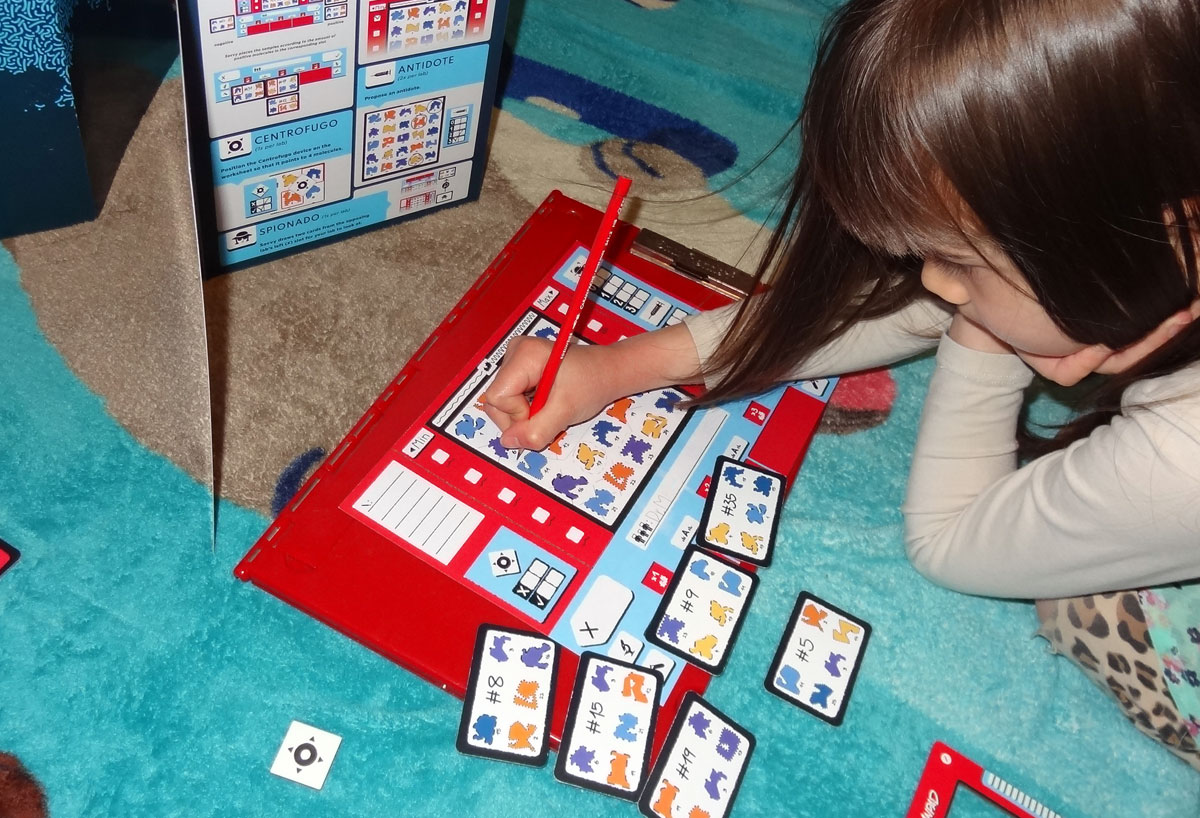
You get two chances to find the antidote. If you use your antidote card and get it wrong, the other lab will know that you’re close and may try to get in a solution quickly on the next round. So you may be tempted to wait until you’ve narrowed things down significantly before making a guess. On the other hand, if you wait until you’re 100% sure, you may be too late! Figuring out when to submit your guess—and how certain you need to be—can be a tough decision.
There can be a bit of luck involved, just in terms of which sample cards you draw during Samply or whether your Dedukto results overlap with things you’ve already eliminated. One lab might get to eliminate molecules from three sample cards at once, while the other lab doesn’t get to eliminate anything. The winner may not always be the one who was smartest about which tools to use, but could be the one who had better luck—though I suppose that could also fit the theme somewhat, too. Sometimes a stroke of luck can be key to a scientific breakthrough.
The real-time aspect of the game, where the team that chooses a card first gets to go first, isn’t too important for most of the game, because if you’re both still doing your initial research, it doesn’t really matter if you use your Samply tool before or after the other lab. Where it does become important is if you want to use Hackz to copy the other lab, and at the end when you’re both racing to submit your antidote. There’s also the one-minute time limit when using the Mikroskopo tool: it doesn’t seem nearly enough to flip through the sample cards (you start with 40 of them, remember?) so it almost feels like a less-effective version of Samply. On the other hand, if you can find some cards that have just the right amount of overlap, it could unlock some crucial results for you.
When I first saw the worksheet, I assumed that there would be some sort of Guess Who?–style deduction, where you might be able to check for a particular color or outline or shape, but I was surprised to find that wasn’t the case. In terms of the gameplay, the molecules could just be a grid of numbers instead and it would work just as well, though it wouldn’t be as fun to look at.
Overall, Save Patient Zero is a fun puzzle game with some light deduction. It’s not too complex—it doesn’t rely as much on logic rules the way that, say, The Search for Planet X does—but my kids and I have enjoyed it. It’s more of a brain tickler than a brain burner, and is good for those who like working out riddles but don’t want to get totally stuck. The big challenge is beating the other lab (or finding your solution more efficiently). I’d recommend it for those who enjoy puzzles, particularly if you’re drawn to the medical theme.
For more information or to make a pledge, visit the Save Patient Zero Kickstarter page!
Click here to see all our tabletop game reviews.
![]() To subscribe to GeekDad’s tabletop gaming coverage, please copy this link and add it to your RSS reader.
To subscribe to GeekDad’s tabletop gaming coverage, please copy this link and add it to your RSS reader.
Disclosure: GeekDad received a prototype of this game for review purposes.






thx for this informative post